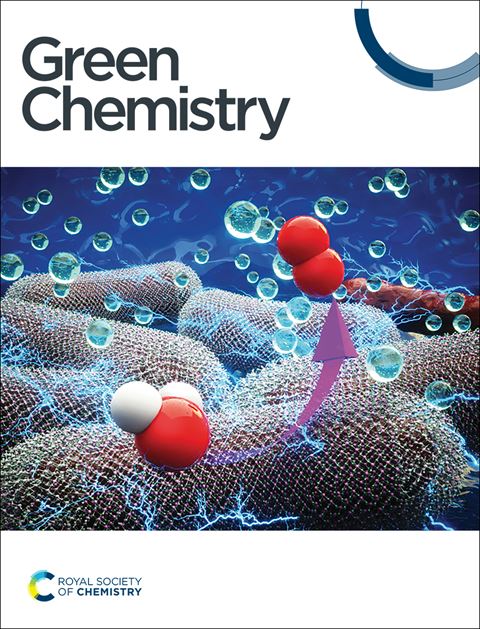“One-for-all” on-demand multifunctional fluorescent amphoteric polymers achieving breakthrough leather eco-manufacturing evolution†
IF 9.2
1区 化学
Q1 CHEMISTRY, MULTIDISCIPLINARY
引用次数: 0
Abstract
The traditional leather industry holds a significant position within the global manufacturing sector, contributing both economically and socially. Relentless multifunctional material-innovation for sustainable leather-manufacture is the only pathway to completely solve the current environmental concerns including widescale discharge of waste and chemicals. Herein, we address these limitations by developing a scalable and sustainable “one-for-all” strategy based on a synthetic multifunctional fluorescent amphoteric polymer (referred to as AADs) through free radical polymerization and amidation grafting reactions achieving a breakthrough leather eco-manufacturing evolution. The resulting AADs effectively integrate the all-round multifunctionalities of tanning, retanning, fatliquoring, regulable color dyeing, and anti-counterfeiting marking into leather. The interfacial multi-point cross-linking of AADs with natural collagen fibers in leather enhances crust-leather with a shrinkage temperature (Ts) exceeding 77 °C and standard-compliant mechanical properties, scratch resistance, and fluorescence for anti-counterfeiting purposes through the creation of distinctive patterns such as barcodes and QR codes. The formative covalent-bonding between the two significantly enhances dye fixation, resulting in leathers with superior durability against rubbing and washing. This innovative process not only reduces the processing time from 1095–2360 min to 500 min and cuts down leather chemical usage by 47.5–74.8%, but also lowers water consumption by 82.6–90% through streamlining multiple primary procedures into a single process. Furthermore, AADs robustly minimize human health risks by 55–71.6% and decrease greenhouse gas emissions by 38.2–52.4% and environmental impacts by 49.3–58.8%, lowering the carbon and environmental footprint of leather production. The innovation of the “one-for-all” process based on emerging multifunctional materials aligns with global sustainability goals, fundamentally aiding the leather industry in transitioning towards more sustainable practices.

“一劳永逸”按需多功能荧光两性聚合物实现突破性皮革生态制造进化†
传统皮革工业在全球制造业中占有重要地位,为经济和社会做出了贡献。持续不断的多功能材料创新可持续皮革制造是彻底解决当前环境问题的唯一途径,包括大规模排放废物和化学品。在此,我们通过自由基聚合和酰胺化接枝反应,开发了一种基于合成多功能荧光两性聚合物(简称AADs)的可扩展和可持续的“一水千金”策略,解决了这些限制,实现了皮革生态制造的突破性发展。由此产生的AADs有效地将鞣制、复鞣制、加脂、可调节颜色染色和防伪标记的全方位多功能集成到皮革中。AADs与皮革中的天然胶原纤维的界面多点交联增强了皮革的收缩温度(Ts)超过77°C,并通过创建条形码和QR码等独特图案,增强了符合标准的机械性能,抗划伤性和防伪荧光。两者之间形成的共价键显着增强了染料的固着性,从而使皮革具有优异的耐摩擦和耐洗涤的耐久性。这一创新工艺不仅将加工时间从1095-2360分钟减少到500分钟,减少了47.5-74.8%的皮革化学品使用量,而且通过将多个主要工序简化为一个工序,将用水量降低了82.6-90%。此外,AADs将人类健康风险降低了55-71.6%,温室气体排放量降低了38.2-52.4%,环境影响降低了49.3-58.8%,降低了皮革生产的碳足迹和环境足迹。基于新兴多功能材料的“一劳永逸”工艺创新符合全球可持续发展目标,从根本上帮助皮革行业向更可持续的实践过渡。
本文章由计算机程序翻译,如有差异,请以英文原文为准。
求助全文
约1分钟内获得全文
求助全文
来源期刊

Green Chemistry
化学-化学综合
CiteScore
16.10
自引率
7.10%
发文量
677
审稿时长
1.4 months
期刊介绍:
Green Chemistry is a journal that provides a unique forum for the publication of innovative research on the development of alternative green and sustainable technologies. The scope of Green Chemistry is based on the definition proposed by Anastas and Warner (Green Chemistry: Theory and Practice, P T Anastas and J C Warner, Oxford University Press, Oxford, 1998), which defines green chemistry as the utilisation of a set of principles that reduces or eliminates the use or generation of hazardous substances in the design, manufacture and application of chemical products. Green Chemistry aims to reduce the environmental impact of the chemical enterprise by developing a technology base that is inherently non-toxic to living things and the environment. The journal welcomes submissions on all aspects of research relating to this endeavor and publishes original and significant cutting-edge research that is likely to be of wide general appeal. For a work to be published, it must present a significant advance in green chemistry, including a comparison with existing methods and a demonstration of advantages over those methods.
 求助内容:
求助内容: 应助结果提醒方式:
应助结果提醒方式:


